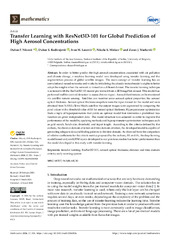Приказ основних података о документу
Transfer Learning with ResNet3D-101 for Global Prediction of High Aerosol Concentrations
| dc.creator | Nikezić, Dušan P. | |
| dc.creator | Radivojević, Dušan S. | |
| dc.creator | Lazović, Ivan | |
| dc.creator | Mirkov, Nikola S. | |
| dc.creator | Marković, Zoran J. | |
| dc.date.accessioned | 2024-03-15T07:17:05Z | |
| dc.date.available | 2024-03-15T07:17:05Z | |
| dc.date.issued | 2024 | |
| dc.identifier.issn | 2227-7390 | |
| dc.identifier.uri | https://vinar.vin.bg.ac.rs/handle/123456789/12988 | |
| dc.description.abstract | In order to better predict the high aerosol concentrations associated with air pollution and climate change, a machine learning model was developed using transfer learning and the segmentation process of global satellite images. The main concept of transfer learning lies on convolutional neural networks and works by initializing the already trained model weights to better adapt the weights when the network is trained on a different dataset. The transfer learning technique was tested with the ResNet3D-101 model pre-trained from a 2D ImageNet dataset. This model has performed well for contrail detection to assess climate impact. Aerosol distributions can be monitored via satellite remote sensing. Satellites can monitor some aerosol optical properties like aerosol optical thickness. Aerosol optical thickness snapshots were the input dataset for the model and were obtained from NASA’s Terra-Modis satellite; the output images were segmented by comparing the pixel values with a threshold value of 0.8 for aerosol optical thickness. Hyperparameter optimization finds a tuple of hyperparameters that yields an optimal model that minimizes a predefined loss function on given independent data. The model structure was adjusted in order to improve the performance of the model by applying methods and hyperparameter optimization techniques such as grid search, batch size, threshold, and input length. According to the criteria defined by the authors, the distance domain criterion and time domain criterion, the developed model is capable of generating adequate data and finding patterns in the time domain. As observed from the comparison of relative coefficients for the criteria metrics proposed by the authors, ddc and dtc, the deep learning model based on ConvLSTM layers developed in our previous studies has better performance than the model developed in this study with transfer learning. | en |
| dc.relation | info:eu-repo/grantAgreement/MESTD/inst-2020/200017/RS// | |
| dc.rights | openAccess | |
| dc.rights.uri | https://creativecommons.org/licenses/by/4.0/ | |
| dc.source | Mathematics | en |
| dc.subject | transfer learning | en |
| dc.subject | ResNet3D-101 | en |
| dc.subject | aerosol optical thickness | en |
| dc.subject | distance and time domain criteria | en |
| dc.subject | early warning system | en |
| dc.title | Transfer Learning with ResNet3D-101 for Global Prediction of High Aerosol Concentrations | en |
| dc.type | article | en |
| dc.rights.license | BY | |
| dc.citation.volume | 12 | |
| dc.citation.issue | 6 | |
| dc.citation.spage | 826 | |
| dc.identifier.doi | 10.3390/math12060826 | |
| dc.type.version | publishedVersion | |
| dc.identifier.fulltext | http://vinar.vin.bg.ac.rs/bitstream/id/35913/mathematics-12-00826-v2.pdf |
Документи
Овај документ се појављује у следећим колекцијама
-
Radovi istraživača
Researchers' publications

